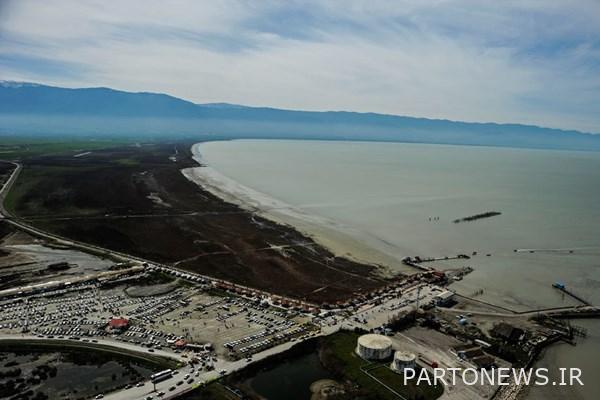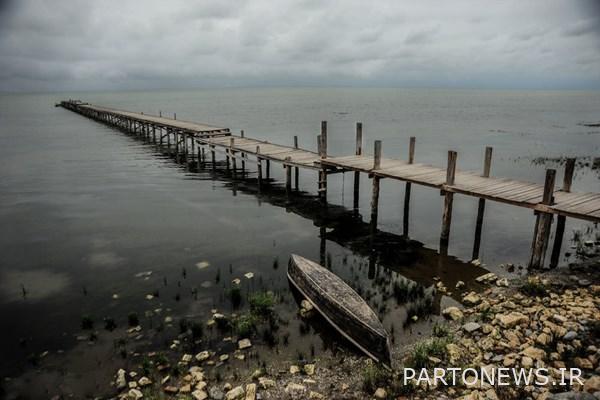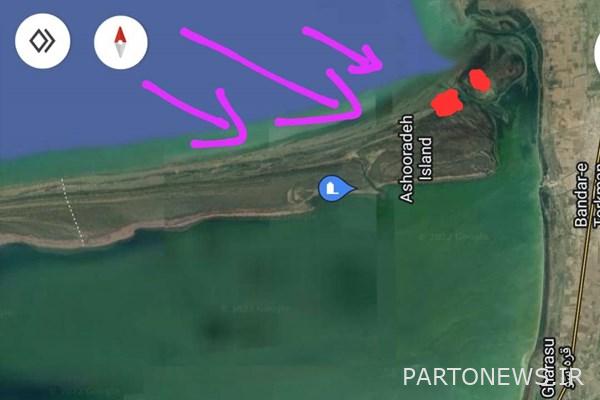Revival and dredging of Gorgan Bay or creating an access channel and building a beach? / Attacking Miankaleh again this time under the pretext of revival!

According to Fars Environment Reporter, Gorgan Bay is one of the largest reservoirs of fresh water connected to the Caspian Sea and the survival of many organisms in the largest lake on earth depends on its connection with the sea. The bay has been plagued by challenges for years, including water scarcity for aquatic regeneration, overhunting, non-dredging of water canals, an increase in the number of dams and upstream fish farms, and these factors have added to the region’s crisis and the need to address it. Has made it more serious.
The registration of Gorgan Bay in 1975 along with Miankaleh and Lepo Zagmorz wetlands in Mazandaran province as the first international wetland complex in the world in the list of wetlands of Ramsar Convention proves that this bay and its surrounding areas are a valuable ecological complex that in addition to preserving the life cycle The Caspian Sea has a direct impact on the livelihood of local communities. Because Gorgan Bay with economic and ecological functions is important in aquatic reproduction, bony and cartilaginous fish, attracting migratory birds and preserving the life cycle of the Caspian Sea and has a direct and important role in the livelihood of local communities.
During his recent visit to the region, the President promised to revive the Miankaleh Lagoon and Gorgan Bay, and the First Vice President informed the Minister of Energy, the Head of the Environmental Protection Organization and the Governor of Golestan to take the necessary decisions as soon as possible. To implement and accelerate the plan to facilitate the connection between the sea and the Gulf of Gorgan to revive this natural area.
The plan to facilitate the exchange of water between the sea and Gorgan Bay with political goals has been proposed by provincial managers
In this regard, recently the plan to facilitate water exchange between the sea and Gorgan Bay in order to prevent drying and salinity of Miankaleh wetland has been approved by Golestan governor’s officials, who are considered by environmental experts and activists as a purely development plan that Golestan managers have been considering for years. It is currently being implemented using the title “water exchange facilitation plan, etc.” and in fact in order to access the sea and facilitate the movement of vessels and economic issues, etc. is being implemented.
They believe that this plan is only in line with the goals of the political leaders of Golestan province and has no help in reviving or even preventing the destruction of Gorgan Bay. The location of the sediment depot in the best areas of the wetland has been suggested, which leads to the negligence of the executor and the reader to the issue of environment.
If we increase the connections between the Caspian Sea and Gorgan Bay, there will be no change in the water level of Gorgan Bay
Razia Lak; The head of the Geosciences Research Institute of the Geological Survey had previously stated in an interview that now that the water level in the Caspian Sea has receded and the water connection with the Gorgan Bay seems to be limited, the point is that even if the water connection is weak With the bay, the water in the Caspian Sea is exchanged equally with the Gulf of Gorgan, and it is not the case that if dredging is done, the amount of water entering the bay will increase! If we increase the connections between the Caspian Sea and Gorgan Bay, there will be no change in the water level of Gorgan Bay, and as a result, dredging the canals will have no effect on increasing the water level of Gorgan Bay.
The head of the Geosciences Research Institute of the Geological Survey of Minerals and Exploration has also stated that what is doubtful is that when we do dredging and increase the Caspian Sea connection with the Gulf of Gorgan, because of the currents The Caspian Sea is sloping in the southeastern part and towards Ashuradeh and Chapqali canals. Increasing the connection of sea water with Gorgan Bay according to the direction of flow can cause more sediment to enter Gorgan Bay.
Lak explained: “Since the flow in Gorgan Bay is horizontal and from east to west and is not very intense, this bay is not able to return the sediment to the Caspian Sea, and therefore increasing the connection of sea water with Gorgan Bay causes more sediment to enter.” Will go to Gorgan Bay; When more sediment enters the Gulf of Gorgan, the depth of the bay decreases more rapidly and the rate of drying of this bay increases, which will eventually lead to the complete destruction of the ecosystem of this region.
According to the data of the National Mapping Organization, more than 30% of the 400 square kilometers of Gorgan Bay has dried up in recent years. The Director General of Ports and Maritime Affairs of Golestan has said: According to the latest estimates, the amount of sediment removal in the Chapqali canal is 1.2 million cubic meters and in the Ashuradeh canal is 800,000 cubic meters.

The implementation of the Gorgan Bay dredging project is a temporary shelter and treatment
After the president’s visit to Golestan province, there was talk of allocating 400 billion funds for dredging the bay. While Mohammad Reza Rezaei-Kochi, the head of the Civil Commission of the Islamic Consultative Assembly, has said: the implementation of the Gorgan Bay dredging project has a budget line every year. However, these resources have been available for years, but they have not been able to make the necessary use of them.
Emphasizing that basic work needs to be done on Gorgan Bay, because dredging is a temporary shelter and treatment, he said: “Of course, for dredging the Gulf, given the current situation, a significant amount is needed, which we hope we can do in parliament.” Approve the credits and the government will make the allocation on time.
Opening the mouth of Gorgan Bay and dredging it is not a reliable scenario on the table of decision makers
But environmental experts do not see dredging as a way to save the bay, said Mazdak Derbeki, a member of the World Union for Conservation of Nature’s protected areas commission. Dredging this crater is one of the options, but the project consultant can not be sure that water will remain in Gorgan Bay after dredging. Therefore, detailed studies should be done in this regard.

Gorgan Bay will sooner or later separate from the Caspian Sea
Abdolmajid Naderi, a member of the faculty of the National Institute of Oceanography and Atmospheric Sciences, also stated: Gorgan Bay will sooner or later be separated from the Caspian Sea. Even the rising Caspian Sea will not be able to help keep the bay open, as sedimentation continues along Miankale. Measures such as dredging the entrance to Gorgan Bay, which we are doing today, although it can provide an opportunity for further actions, such measures are temporary and costly.
Canalization completely destroys the habitat of Miankale
Hamed Tizroyan, an environmental activist on his social media page, pointed to the opposition of the Mazandaran Environment Department and the head of the Miankaleh Biosphere Reserve to a plan that is ostensibly intended for dredging the area but facilitates a boating plan for tourism. He said that a canal with a length of 2.8 km and a width of 100-400 meters and a depth of 1.5 meters is to be built. It is in the best part of Miankaleh habitat that this canalization causes the complete destruction of this part and its very important habitat. And the intermediate dry process occurs faster.
He added: “Therefore, due to the trend behind the sea, this canal is located in a part of Miankaleh, where the slope of the underwater surface towards the same canal can happen faster.”
Discharge of one million and two hundred thousand cubic meters of sediment in the biosphere reserve
According to Tizroyan, this project will drain the volume of one million and two hundred thousand cubic meters of sediment from the construction canal in parts of the best parts of this habitat, ie in an area of nearly 100 hectares and in the biosphere reserve, and the problem is that The purpose of this project is not to rehabilitate the wetland, and only to facilitate the movement of boats, and provincial officials have no plans to rehabilitate it.

Sedimentary island will be a source of fine dust in the northeast of the country
Har Mansouri, an environmental activist, believes that if a 100-hectare sediment forms an island in two red dots 1.5 to 2 meters high, it will lose its moisture in the next few months due to its very short distance from the port. Turkmen will be the source of dust in the Turkmen city. Exactly the direction of the wind from northwest to southeast and towards the port.
He said that the main goal of the governorate to create access to the sea is only for tourism purposes and to create a beach, and said: “In fact, Golestan does not have a sandy beach and to access the marine environment, they have to travel more than 100 kilometers.” And Miankaleh wetland is creating access to the safest part of Miankaleh beach.
Why is there a budget for this destructive plan but not for the rehabilitation of the wetland?
The question is, why is there a budget for this destructive plan but not for the rehabilitation of the wetland? Meanwhile, the sewage of the cities around this wetland enters the wetland with a very large volume without treatment, and no solution has been considered for the situation, and now it has become one of the biggest problems of the wetland. While providing water to the lagoon and preventing the entry of various wastewater that enters it without treatment, is the best solution.
Given the optimistic possibility that dredging is to take place to protect the environment, the question arises as to why the canal passes through Ashuradeh, the best bird habitat in the region, while the Chapqali canal is located in the easternmost part of Miankaleh. It is better.
End of message /

